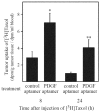Nucleic acid aptamers for target validation and therapeutic applications
- PMID: 16461946
- PMCID: PMC2291729
Nucleic acid aptamers for target validation and therapeutic applications
Abstract
In the simplest view, aptamers can be thought of as nucleic acid analogs to antibodies. They are able to bind specifically to proteins, and, in many cases, that binding leads to a modulation of protein activity. New aptamers are rapidly generated through the SELEX (Systematic Evolution of Ligands by Exponential enrichment) process and have a very high target affinity and specificity (picomoles to nanomoles). Furthermore, aptamers composed of modified nucleotides have a long in vivo half-life (hours to days), are nontoxic and nonimmunogenic, and are easily produced using standard nucleic acid synthesis methods. These properties make aptamers ideal for target validation and as a new class of therapeutics. As a target validation tool, aptamers provide important information that complements that provided by other methods. For example, siRNA is widely used to demonstrate that protein knock-out in a cellular assay can lead to a biological effect. Aptamers extend that information by showing that the dose-dependent modulation of protein activity can be used to derive a therapeutic benefit. That is, aptamers can be used to demonstrate that the protein is a good target for drug development. As a new class of therapeutics, aptamers bridge the gap between small molecules and biologics. Like biologics, biologically active aptamers are rapidly discovered, have no class-specific toxicity, and are adept at disrupting protein-protein interaction. Like small molecules, aptamers can be rationally engineered and optimized, are nonimmunogenic, and are produced by scalable chemical procedures at moderate cost. As such, aptamers are emerging as an important source of new therapeutic molecules.
Figures





Similar articles
-
Nucleic acid aptamers as tools and drugs: recent developments.Chembiochem. 2003 Oct 6;4(10):963-71. doi: 10.1002/cbic.200300648. Chembiochem. 2003. PMID: 14523912 Review.
-
Aptamers: a new class of oligonucleotides in the drug discovery pipeline?Curr Opin Pharmacol. 2009 Oct;9(5):602-7. doi: 10.1016/j.coph.2009.07.006. Epub 2009 Aug 28. Curr Opin Pharmacol. 2009. PMID: 19717337 Review.
-
SELEX--a (r)evolutionary method to generate high-affinity nucleic acid ligands.Biomol Eng. 2007 Oct;24(4):381-403. doi: 10.1016/j.bioeng.2007.06.001. Epub 2007 Jun 16. Biomol Eng. 2007. PMID: 17627883 Review.
-
[Aptamers in clinical diagnostics].Postepy Biochem. 2006;52(3):260-70. Postepy Biochem. 2006. PMID: 17201061 Review. Polish.
-
Nucleic acid aptamers as adjuncts to vaccine development.Curr Opin Mol Ther. 2006 Apr;8(2):122-9. Curr Opin Mol Ther. 2006. PMID: 16610764 Review.
Cited by
-
Connective tissue growth factor-targeting DNA aptamer suppresses pannus formation as diagnostics and therapeutics for rheumatoid arthritis.Front Immunol. 2022 Aug 5;13:934061. doi: 10.3389/fimmu.2022.934061. eCollection 2022. Front Immunol. 2022. PMID: 35990694 Free PMC article.
-
Anti-Transcription Factor RNA Aptamers as Potential Therapeutics.Nucleic Acid Ther. 2016 Feb;26(1):29-43. doi: 10.1089/nat.2015.0566. Epub 2015 Oct 28. Nucleic Acid Ther. 2016. PMID: 26509637 Free PMC article. Review.
-
Advancing cancer treatments: The role of oligonucleotide-based therapies in driving progress.Mol Ther Nucleic Acids. 2024 Jun 17;35(3):102256. doi: 10.1016/j.omtn.2024.102256. eCollection 2024 Sep 10. Mol Ther Nucleic Acids. 2024. PMID: 39045515 Free PMC article. Review.
-
Nucleic acid aptamers: research tools in disease diagnostics and therapeutics.Biomed Res Int. 2014;2014:540451. doi: 10.1155/2014/540451. Epub 2014 Jun 22. Biomed Res Int. 2014. PMID: 25050359 Free PMC article. Review.
-
MIPs and Aptamers for Recognition of Proteins in Biomimetic Sensing.Biosensors (Basel). 2016 Jul 18;6(3):35. doi: 10.3390/bios6030035. Biosensors (Basel). 2016. PMID: 27438862 Free PMC article. Review.
References
-
- Jellinek D, et al. Potent 2′-amino-2′-deoxypyrimidine RNA inhibitors of basic fibroblast growth factor. Biochemistry 1995;34:11363–11372. - PubMed
-
- Seiwert SD, Stines Nahreini T, Aigner S, Ahn NG, Uhlenbeck OC. RNA aptamers as pathway-specific MAP kinase inhibitors. Chem Biol 2000;7:833–843. - PubMed
-
- Tuerk C, Gold L. Systematic evolution of ligands by exponential enrichment: RNA ligands to bacterial T4 DNA polymerase. Science 1990;249:505–510. - PubMed
-
- Ellington AD, Szostak JW. In vitro selection of RNA molecules that bind specific ligands. Nature 1990; 346:818–822. - PubMed
-
- Cox JC, et al. Automated acquisition of aptamer sequences. Comb Chem High Throughput Screen 2002;5: 289–299. - PubMed
Publication types
MeSH terms
Substances
LinkOut - more resources
Full Text Sources
Other Literature Sources
Research Materials
Miscellaneous
